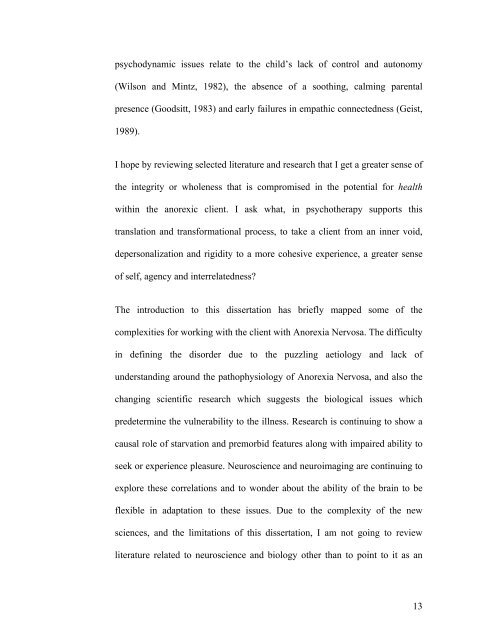“Ghosts at the banquet” - Scholarly Commons Home
“Ghosts at the banquet” - Scholarly Commons Home
“Ghosts at the banquet” - Scholarly Commons Home
Create successful ePaper yourself
Turn your PDF publications into a flip-book with our unique Google optimized e-Paper software.
psychodynamic issues rel<strong>at</strong>e to <strong>the</strong> child’s lack of control and autonomy<br />
(Wilson and Mintz, 1982), <strong>the</strong> absence of a soothing, calming parental<br />
presence (Goodsitt, 1983) and early failures in emp<strong>at</strong>hic connectedness (Geist,<br />
1989).<br />
I hope by reviewing selected liter<strong>at</strong>ure and research th<strong>at</strong> I get a gre<strong>at</strong>er sense of<br />
<strong>the</strong> integrity or wholeness th<strong>at</strong> is compromised in <strong>the</strong> potential for health<br />
within <strong>the</strong> anorexic client. I ask wh<strong>at</strong>, in psycho<strong>the</strong>rapy supports this<br />
transl<strong>at</strong>ion and transform<strong>at</strong>ional process, to take a client from an inner void,<br />
depersonaliz<strong>at</strong>ion and rigidity to a more cohesive experience, a gre<strong>at</strong>er sense<br />
of self, agency and interrel<strong>at</strong>edness?<br />
The introduction to this dissert<strong>at</strong>ion has briefly mapped some of <strong>the</strong><br />
complexities for working with <strong>the</strong> client with Anorexia Nervosa. The difficulty<br />
in defining <strong>the</strong> disorder due to <strong>the</strong> puzzling aetiology and lack of<br />
understanding around <strong>the</strong> p<strong>at</strong>hophysiology of Anorexia Nervosa, and also <strong>the</strong><br />
changing scientific research which suggests <strong>the</strong> biological issues which<br />
predetermine <strong>the</strong> vulnerability to <strong>the</strong> illness. Research is continuing to show a<br />
causal role of starv<strong>at</strong>ion and premorbid fe<strong>at</strong>ures along with impaired ability to<br />
seek or experience pleasure. Neuroscience and neuroimaging are continuing to<br />
explore <strong>the</strong>se correl<strong>at</strong>ions and to wonder about <strong>the</strong> ability of <strong>the</strong> brain to be<br />
flexible in adapt<strong>at</strong>ion to <strong>the</strong>se issues. Due to <strong>the</strong> complexity of <strong>the</strong> new<br />
sciences, and <strong>the</strong> limit<strong>at</strong>ions of this dissert<strong>at</strong>ion, I am not going to review<br />
liter<strong>at</strong>ure rel<strong>at</strong>ed to neuroscience and biology o<strong>the</strong>r than to point to it as an<br />
13
















